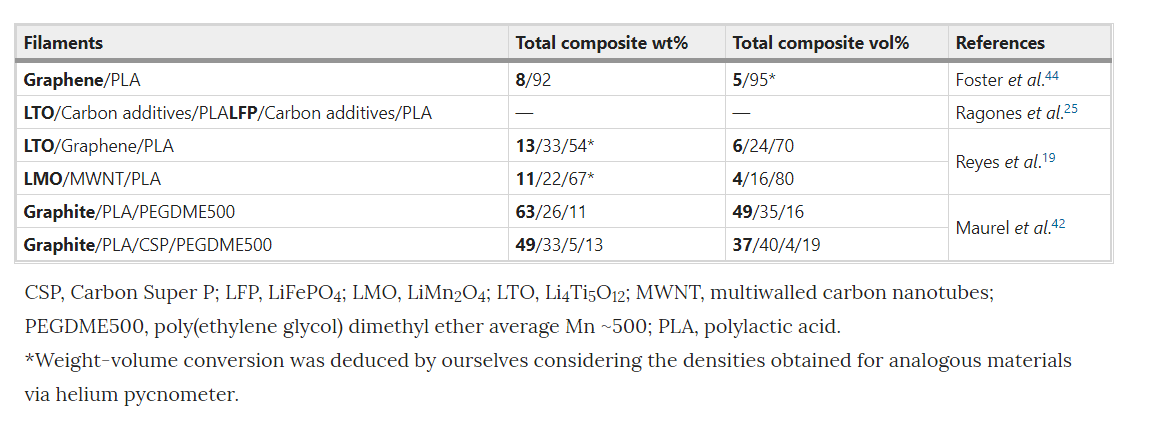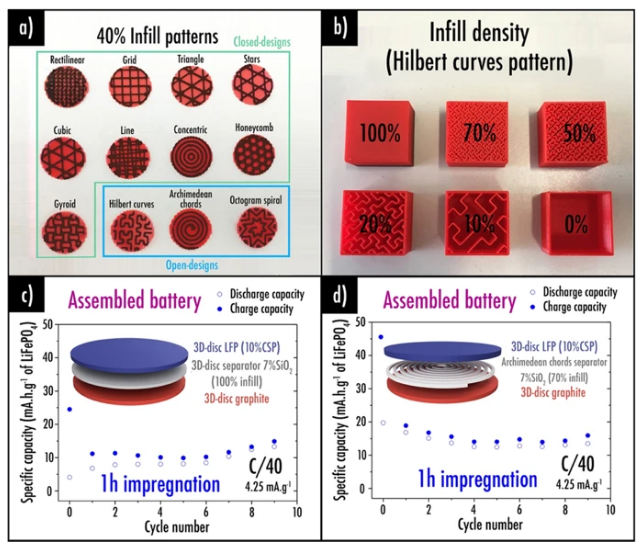In the recently published ‘Three-Dimensional Printing of a LiFePO4/Graphite Battery Cell via Fused Deposition Modeling,’ French researchers explore improved ways to create batteries. The researchers chose FDM 3D printing due to its versatility, accompanied by a graphite/PLA filament.
Energy and sustainability are widely-discussed topics—and concerns—around the world today, and as the technology of 3D printing has continued to progress via a wide range of different software, hardware, and materials, so has innovation in areas like energy storage and batteries. This includes customization of shapes, to include:
- Electrodes
- Separators
- Solid polymer electrolytes
- Current collectors
Today, batteries and electronics can be directly integrated into 3D printed products, as a direct result of the need to ‘maximize energy storage while reducing volume and weight…’ Previous researchers have used commercial graphene-based polylactic acid filament as material, successfully 3D printing devices; however, loading of materials was consistently low enough to impact electrochemical performances substantially.

Summary of filaments characteristics prepared for FDM process reported in literature. Helium pycnometer material densities were used for weight-volume conversion.
For this study, the researchers were already aware that the material limitations could be overcome with the addition of a plasticizer:
“Indeed, we reported a highly loaded 3D printable graphite/PLA filament specifically conceived to be employed as negative electrode in a lithium-ion battery and to feed a conventional FDM 3D printer. Active material content (graphite) within the filament, was increased as high as possible (49.2 wt% of graphite in the total composite thus corresponding to 773 mg of active material per cm3) to improve the electrochemical performances while preserving enough mechanical strength to be printed thanks particularly to the addition of poly(ethylene glycol) dimethyl ether average Mn ∼ 500 acting as plasticizer,” stated the researchers.
“Hence, an unprecedent reversible capacity for a negative electrode disc obtained via FDM was achieved: 200 mAh g−1 of active material (99 mAh g−1 of the total composite or also to 154.6 mAh cm−3) at current density of 18.6 mA g−1 (C/20) after 6 cycles and 140 mAh g−1 of active material (69 mAh g−1 of the total composite or also 108.2 mAh cm−3) at current density of 37.3 mA g−1 (C/10).”
The researchers furthered their work, however, centering the study around optimizing both LFP-PLA and PLA-SiO2 composite-based 3D-printing filaments as they explored the use of carbon black for the conductive additive for the positive electrode and ceramic additives in the separator. With the flexibility afforded through 3D printing, more complex geometries can be created, along with better optimization of materials, and easier assembly as all the parts can be created at one time.
“Well aware of the limitations induced by nominal resolution of 3D printer, this work serves here as proof of concept,” stated the researchers.

(a) Formulation process: (1) After mixing all of the components into a solvent, slurry is spread on a glass support by doctor blading technique and a film is finally obtained; (2) Composite film homogeneous pieces are introduced in an extruder. A typical 1.75 mm diameter 3D-printing filament is obtained and rolled; (3) Filament is introduced into a commercial FDM 3D-printer; DSC curves: (b) pure PLA, PLA/LFP wt% 40/60 and PLA/LFP/PEGDME500 with different amount of conductive additive (CSP); (c) comparison between film, filament, and 3D-printed disc for the 10%CSP sample.
The plasticizer, poly(ethylene glycol) dimethyl ether average Mn~500 (PEGDME500), was used, with a little exothermal crystallization peak (Tc) around 80 °C’ induced. Temperature differences were constant, and according to the researchers, the plasticized PLA/LFP films displayed Tm inferior than without plasticizer, diminishing from 142 °C to about 132 °C.
To encourage conductivity, the research team created samples with a varying range of CSP. When this content was increased, endothermal peaks were unchanged; however, this was not the case for the exothermal crystallization peak (Tc), which was altered to lower temperature, reaching 74 °C for the 20% CSP sample. The scientists stated that such behavior could possibly be attributed to the CSP in the PLA matrix.
3D printed samples were fabricated using a Prusa MK3 3D printer.
“This study, by merging both battery and 3D-printing technologies, addressed numerous electrochemical (thickness, electronic and ionic conductivity, electrolyte uptake) and 3D printing parameters (infill density, infill pattern, perimeters, over and under-extrusion, retraction), and opens the way for a better performing 3D printed lithium-ion battery,” concluded the researchers.
“Finally, as this work acts here as proof of concept, authors are well-aware that for now electrodes and separator patterns are 2D and thus achievable using non 3D printing techniques. Future work, however, would be concentrated on complex 3D-battery architectures that necessitates significant system adjustments and a thorough design optimization. Upcoming research may also be dedicated to mechanically ameliorate the FDM 3D-printer resolution and simplify the tedious steps to print the full-battery in one-shot by using a multi-nozzle configuration.”
Researchers continue to seek better ways to 3D print batteries, from customizing bespoke filament to 3D freeze printing, innovating for wearables, and more. What do you think of this news? Let us know your thoughts! Join the discussion of this and other 3D printing topics at 3DPrintBoard.com.

(a) Arrhenius plots of the electrical conductivity for samples containing CSP as conductive additives; (b) Capacity retention plots at different C-rate for the film and 3D-printed disc 10%CSP sample. (c) Charge/discharge capacity profiles for the 3D-printed disc 10%CSP sample. Note that for those experiments, a commercial fiber glass separator was used; (d) Conductivity after 1 h and 10 h within the electrolyte 1 M LiPF6 in EC:DEC 1:1 vol% for samples containing different SiO2 content.

(a) Different separator infill patterns that can be obtained by using classic 3D-printing slicer software (40% infill density); (b) Various infill densities of the same infill pattern (Hilbert curves); Capacity retention plots at 4.25 mA.g−1 (C/40) for the complete assembled battery after 1 h impregnation: (c) using 100% infill density separator and (d) using a 70%infill density Archimedean chords pattern. Here, note that each layer is 200 µm thick.
[Source / Images: ‘Three-Dimensional Printing of a LiFePO4/Graphite Battery Cell via Fused Deposition Modeling’]
The post France: FDM 3D Printing with Graphite for Better Battery Cells appeared first on 3DPrint.com | The Voice of 3D Printing / Additive Manufacturing.

73 Replies to “France: FDM 3D Printing with Graphite for Better Battery Cells”
Comments are closed.